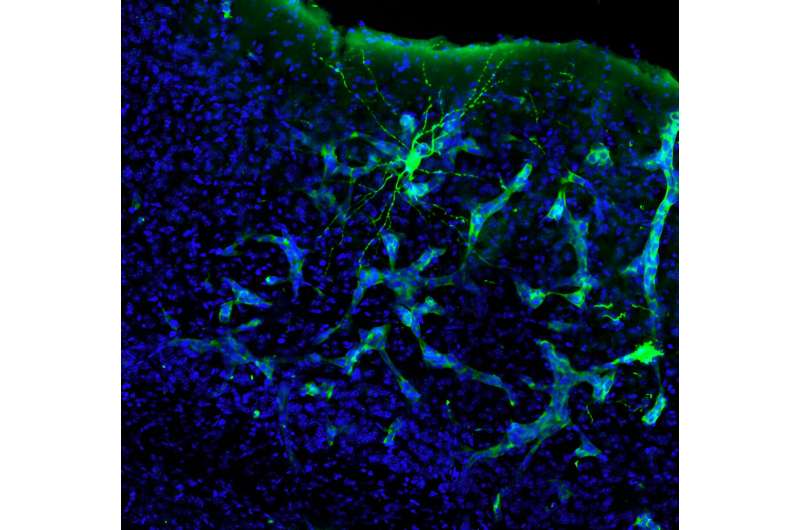This article has been reviewed according to Science X's editorial process and policies. Editors have highlighted the following attributes while ensuring the content's credibility:
fact-checked
peer-reviewed publication
trusted source
proofread
Study finds that brain tumors 'hack' the communication between neurons

Nearly half of all patients with brain metastasis experience cognitive impairment. Until now, it was thought that this was due to the physical presence of the tumor pressing on neural tissue. But this "mass effect" hypothesis is flawed because there is often no relationship between the size of the tumor and its cognitive impact. Small tumors can cause significant changes, and large tumors can produce mild effects. Why is this?
The explanation may lie in the fact that brain metastasis hacks the brain's activity, a study featured on Cancer Cell's cover shows for the first time.
The authors, from the Spanish National Research Council (CSIC) and the Spanish National Cancer Research Center (CNIO), have discovered that when cancer spreads (metastasizes) in the brain, it changes the brain's chemistry and disrupts neuronal communication—neurons communicate through electrical impulses generated and transmitted by biochemical changes in the cells and their surroundings.
In this study, the laboratories of Manuel Valiente (CNIO) and Liset Menéndez de La Prida (Cajal Institute CSIC) have collaborated within the NanoBRIGHT project, aimed at developing new technologies for the study of the brain, and with the participation of other agencies such as MICINN, AECC, ERC, NIH and EMBO.
Demonstration with artificial intelligence
The researchers measured the electrical activity of the brains of mice with and without metastases and observed that the electrophysiological recordings of the two groups of animals with cancer were different from each other. To be sure that this difference was attributable to metastases, they turned to artificial intelligence.
They trained an automatic algorithm with numerous electrophysiological recordings, and the model was indeed able to identify the presence of metastases. The system was even able to distinguish metastases from different primary tumors—skin, lung and breast cancer.
These results show that metastasis does indeed affect the brain's electrical activity in a specific way, leaving clear and recognizable signatures.
For the authors, the study represents a "paradigm shift" in the basic understanding of the development of brain metastases and has implications for the prevention, early diagnosis and treatment of this pathology.
On the trail of a drug against neurocognitive effects
In addition to recording changes in brain electrical activity in the presence of metastasis, the researchers have begun to explore the biochemical changes that might explain this alteration. By analyzing the genes expressed in the affected tissues, they have identified a molecule, EGR1, that may play an important role in this process. This finding opens up the possibility of designing a drug to prevent or alleviate the neurocognitive effects of brain metastasis.
As Manuel Valiente, head of the CNIO's Brain Metastasis Group explains, "our multidisciplinary study challenges the hitherto accepted assumption that neurological dysfunction, which is very common in patients with brain metastasis, is due solely to the mass effect of the tumor. We suggest that these symptoms are a consequence of changes in brain activity resulting from tumor-induced biochemical and molecular alterations. This is a paradigm shift that could have important implications for diagnosis and therapeutic strategies."
Liset Menéndez de la Prida, director of the Laboratory of Neural Circuits the Cajal Institute (CSIC), says, "Using machine learning, we have been able to integrate all the data to create a model that allows us to know whether there is or not metastasis in a brain, just by looking at its electrical activity. This computational approach may even be able to predict subtypes of brain metastases at an early stage. It is a completely pioneering work that opens up an unexplored path."
Both authors emphasize the multidisciplinary nature of this complex study that combines neuroscience, oncology and computational analysis, each using a wide range of different techniques.
Cognitive study of patients and development of non-invasive techniques
The change in focus brought about by this result means that researchers now want to analyze the cognitive status of patients with brain metastasis much more systematically.
For Valiente, this is one of the most important next steps. The key to this will be the National Brain Metastasis Network (RENACER) initiated and coordinated by CNIO, which has already served to generate the largest collection of living brain metastasis samples in the world (with prior consent from patients, tissue samples collected during surgical interventions are made available to the international scientific community in the CNIO Biobank), and in which they will now introduce protocols for the neurocognitive assessment of the participating patients.
For her part, Liset Menéndez de La Prida will work on integrating the recording of brain activity with the analysis of the molecules involved, "in order to develop new diagnostic probes for brain tumors," she says. This task is in line with the European NanoBRIGHT project, which aims to develop non-invasive techniques for studying the brain and treating its pathologies, and in which CSIC and CNIO are participating.
Another goal is to find drugs that protect the brain from cancer-induced disruptions in neuronal circuits, using the strategies described above. "We will look for molecules involved in metastasis-induced changes in neuronal communication, and evaluate them as possible therapeutic targets," explains Valiente.
In addition to the artificial intelligence developed by the CSIC team, they will use the METPlatform technology designed by CNIO to evaluate the potential therapeutic activity of hundreds of compounds simultaneously on brain tissue samples affected by metastasis.
More information: Manuel Valiente, Machine learning identifies experimental brain metastasis subtypes based on their influence on neural circuits., Cancer Cell (2023). DOI: 10.1016/j.ccell.2023.07.010. www.cell.com/cancer-cell/fullt … 1535-6108(23)00250-7




















